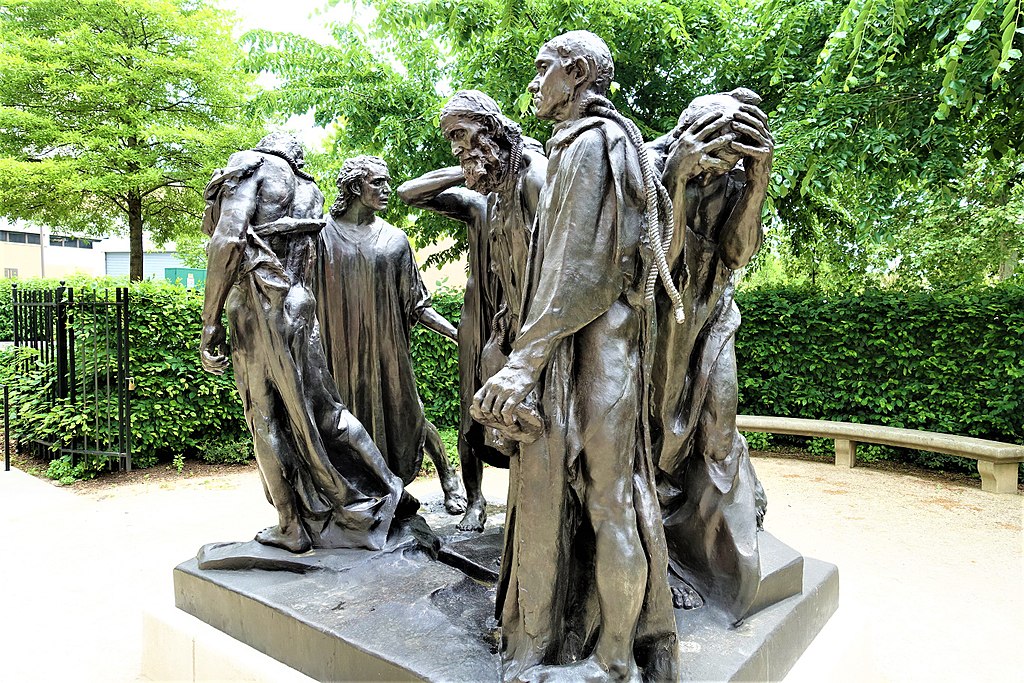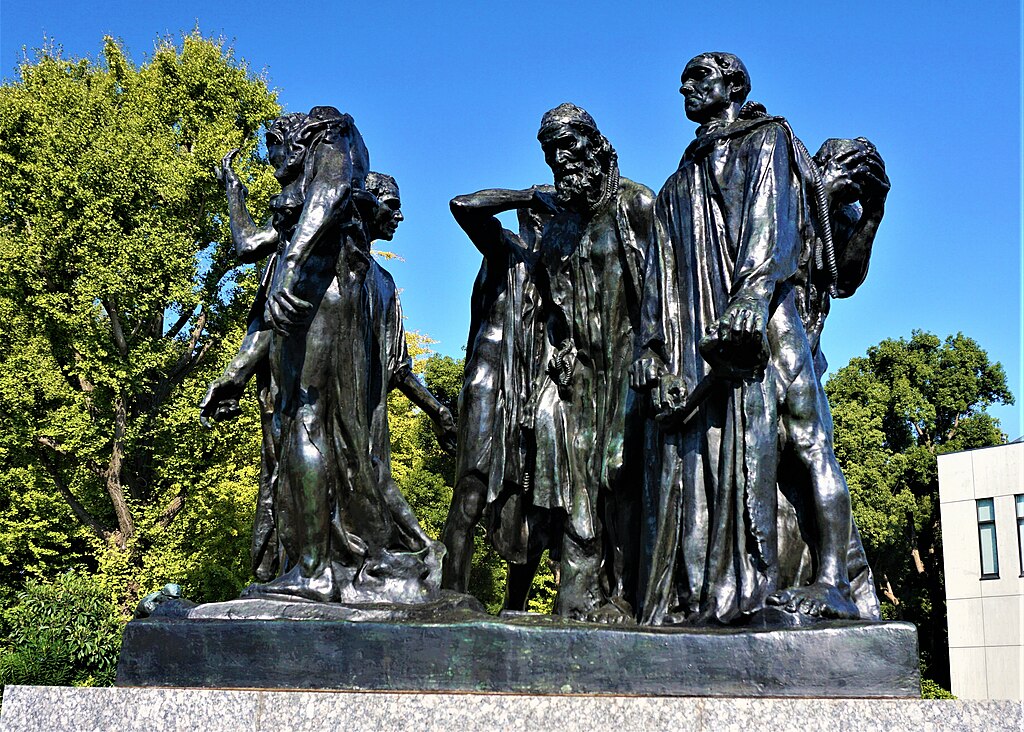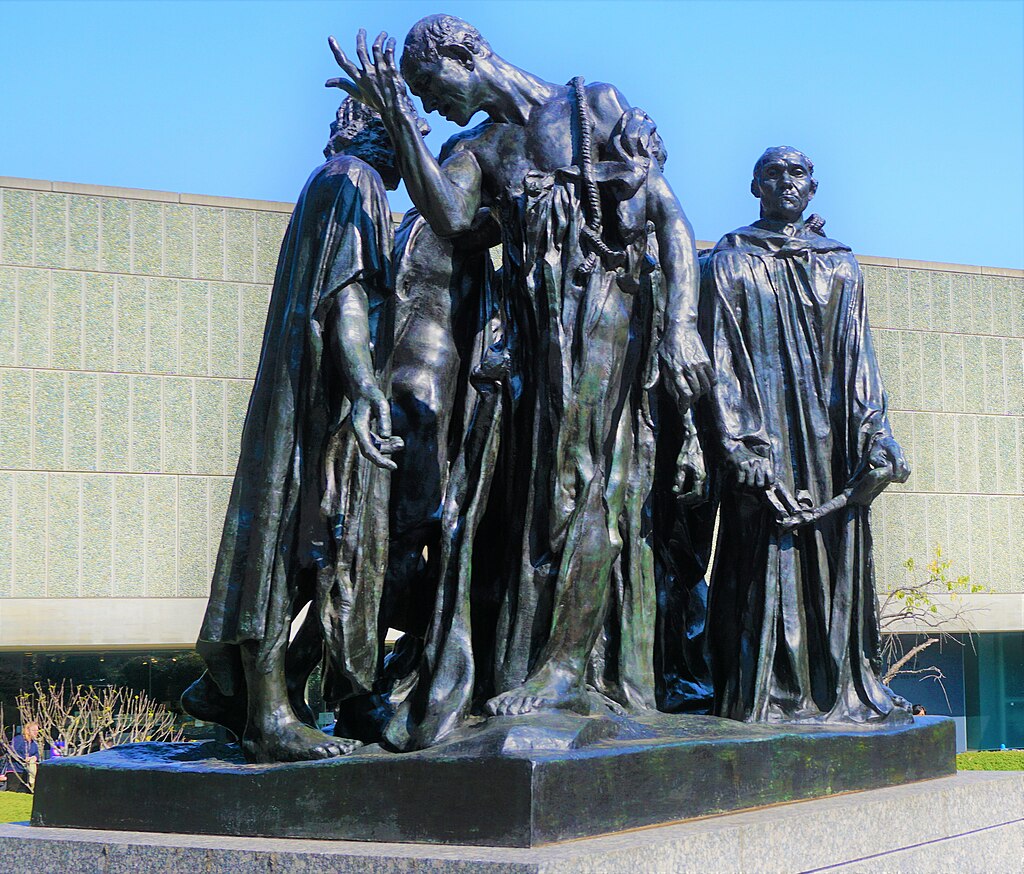
“The Burghers of Calais” by Auguste Rodin is one of his most famous sculptures. It commemorates a historical incident during the Hundred Years’ War, when Calais, a prominent French port on the English Channel, was under siege by the English for over a year and was forced to surrender.
The victors offered to spare the city if six of its leaders would surrender themselves and walk out wearing nooses around their necks, carrying the keys to the town and castle.
One of the wealthiest of the town leaders volunteered, and five other burghers volunteered to join him. It is this moment when the volunteers leave the city gates that this sculpture depicts.
Rodin captured the poignant mix of defeat, heroic self-sacrifice, and willingness to face imminent death.
The Hundred Years’ War was a series of conflicts waged from 1337 to 1453 by England against France over the succession to the French throne.
Calais overlooks the Strait of Dover, the narrowest point in the English Channel, and during this prolonged conflict, England laid siege to Calais.
King Philip VI of France ordered the city to hold out at all costs. Philip, unfortunately, failed to lift the blockade and starvation eventually forced the city to surrender.
The Burghers of Calais – Hirshhorn Museum and Sculpture Garden – Washington, D.C.
The lives of the Burghers were spared by the intervention of England’s queen, who persuaded her husband King Edward III, the victor siege to Calais, to exercise mercy by claiming that their deaths would be a bad omen for her unborn child. Unfortunately, her son only lived for one year.
Calais commissioned Rodin to create the sculpture, and the work was completed in 1889. Unfortunately, Rodin’s design was not understood or appreciated and was controversial at the time.
The public expected grand heroic statues on massive pedestals with the traditional heroic glory motifs. Instead, Rodin portrayed the Burghers in pain, anguish, and noble self-sacrifice and intended to place the statue at the ground level.
Today Rodin’s vision has become famous for its poignancy. No more than twelve original casts of Rodin’s works may be made under French law.
The first cast of 1895 still stands in Calais; the other original casts stand in museums and educational institutions across the world.
The “Hirshhorn Museum and Sculpture Garden” version is one of the twelve original casts and was cast in 1943 and installed in 1966.

The Burghers of Calais – National Museum of Western Art, Tokyo
Siege of Calais
The Siege of Calais (1346 – 1347) was when the English army under the command of King Edward III of England successfully besieged the French garrison of Calais.
At the start of the siege, although the English had surrounded the port, their siege lines were not tight, and the French were still able to get supplies into Calais, usually by sea.
Once it became clear to Edward that an assault was unlikely to be successful, he tightened the siege of the city, including the sea approaches.
The reinforcement of the blockade increased significantly and ultimately proved successful, and the town surrendered, due to the lack of provisions, nearly one year after the siege started.
The capture of Calais provided the English with a strategic port for the rest of the Hundred Years’ War. The port was not recaptured by the French until 200 hundred years later, in the 1558 siege of Calais.

Rodin Museum, Philadelphia
Calais
Calais in northern France overlooks the Strait of Dover, the narrowest point in the English Channel, which is only 34 km (21 mi) wide. It is the closest French town to England, and the White Cliffs of Dover can easily be seen on a clear day from Calais.
Due to its position, Calais since the Middle Ages has been a significant port and a vital center for transport and trading with England.
Calais came under English control after Edward III of England captured the city in 1347, followed by a treaty in 1360 that formally assigned Calais to English rule.
Though Edward III spared the lives of the Burghers, he drove out most of the French inhabitants and settled the town with English.
Calais then grew into a thriving center for wool production and came to be called the “brightest jewel in the English crown” owing to its great importance as the gateway for the tin, lead, lace, and wool trades.
Calais remained under English control until its capture by France in 1558. The town was virtually razed to the ground during World War II when in 1940, it was a bombing target of the invading German forces who took the city during the Siege of Calais.
During World War II, the Germans built massive bunkers along the coast in preparation for launching missiles on England.
Original casts of The Burghers of Calais
No more than twelve original casts of Rodin’s works may be made under French law. The first cast of 1895 still stands in Calais; the other original casts are exhibited in museums and educational institutions across the world.
“The Rodin Museum” version is one of the twelve original casts and was cast in 1919 – 21 and installed in 1929.
The 1895 cast of the group of six figures still stands in Calais. Other original casts can be seen at:
- Smithsonian Hirshhorn Museum and Sculpture Garden in Washington, DC
- National Museum of Western Art in Tokyo
- Norton Simon Museum in Pasadena, California
- Metropolitan Museum of Art in New York City
- Rodin Museum in Philadelphia
- Victoria Tower Gardens in the shadow of the Houses of Parliament in London
- Musée Rodin in Paris
- Kunstmuseum in Basel
- Glyptoteket in Copenhagen
- Musée royal de Mariemont in Morlanwelz, Belgium
- Plateau in Seoul.
Copies of individual statues can be seen at:
- Stanford University, USA
- Los Angeles County Museum of Art in the Sculpture Garden, USA
- Visual Arts Center at Davidson College
- Sommerro Park in Oslo, Norway
- World One Trade Center, NY
Auguste Rodin
François Auguste René Rodin (1840 – 1917) was a French sculptor and one of the founders of modern sculpture. Rodin was schooled traditionally and did not set out to rebel from the traditions of sculpture.
However, Rodin’s unique works departed from traditional themes of mythology and allegory.
Rodin’s passion was to model the human body with realism; however, some of his most notable sculptures were criticized during his lifetime. Fortunately, he refused to change his style.
With successive works, Rodin’s reputation grew slowly, and he became the preeminent French sculptor, and by 1900, when he was 60 years old, he was a world-renowned artist.
Rodin is one of the few sculptors widely known outside the specialist visual arts community.
The Burghers of Calais – Rodin Museum, Philadelphia
- Title: The Burghers of Calais
- Artist: Auguste Rodin
- Year: Modelled 1884 – 1889; Cast 1919 – 21; Installed in 1929.
- Material: Bronze Casting
- Museum: Rodin Museum
The Burghers of Calais – Hirshhorn Museum and Sculpture Garden – Washington, D.C.
- Title: The Burghers of Calais
- Artist: Auguste Rodin
- Year: Modelled 1884 – 1889; Cast 1943; Installed in 1966.
- Material: Bronze Casting
- Museum: Hirshhorn Museum and Sculpture Garden
The Burghers of Calais – National Museum of Western Art, Tokyo
- Title: The Burghers of Calais
- Artist: Auguste Rodin
- Year: Modelled 1884 – 1889; Cast 1953
- Place of Origin: France
- Material: Bronze Casting
- Museum: National Museum of Western Art, Tokyo

National Museum of Western Art, Tokyo
Auguste Rodin
- Name: François-Auguste-René Rodin
- Born: 1840 – Paris, France
- Died: 1917 (aged 77) – Meudon, France
- Nationality: French
- Notable work:
- Eternal Springtime (Rodin Museum, Philadelphia)
- Two Hands (Rodin Museum, Philadelphia)
- The Cathedral (Rodin Museum, Philadelphia)
- The Hand of God (Rodin Museum, Philadelphia)
- The Thinker (Rodin Museum, Philadelphia)
- The Gates of Hell (Rodin Museum, Philadelphia)
- “The Gates of Hell” by Auguste Rodin (Kunsthaus Zürich)
- The Hand from the Tomb (Rodin Museum, Philadelphia)
- The Sirens (Rodin Museum, Philadelphia)
- Young Mother in the Grotto (Rodin Museum, Philadelphia)
- Colossal Head of Saint John the Baptist (Rodin Museum, Philadelphia)
- The Secret (Rodin Museum, Philadelphia)
- The Thinker at the Rodin Museum, Philadelphia (Full Size)
- The Thinker at the Rodin Museum, Philadelphia (Medium Size)
- The Thinker ( Cleveland Museum of Art)
- The Thinker (The Legion of Honor)
- The Burghers of Calais
- Balzac (Rodin Museum, Philadelphia)
- Eve (Musée Rodin, Paris)
- Adam (Art Gallery of Western Australia)
- The Kiss (Musée Rodin, Paris)
- Orpheus and Eurydice (Metropolitan Museum of Art – MET)
Burghers of Calais by Auguste Rodin
Burghers of Calais by Auguste Rodin
Burghers of Calais by Auguste Rodin
~~~
“True artists are almost the only people who do their work for pleasure.”
– Auguste Rodin
~~~
Photo Credit: By Joyofmuseums; By AgnosticPreachersKid (Own work) [CC BY-SA 3.0 (creativecommons.org/licenses/by-sa/3.0)], via Wikimedia Commons
Popular this Week








 Sponsor your Favorite Page
Sponsor your Favorite Page SEARCH Search for: Search Follow UsJoin – The JOM Membership Program
Sponsor a Masterpiece with YOUR NAME CHOICE for $5
Share this:
- Tweet

